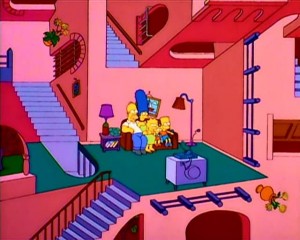The Couch (The Simpsons)
by Mlawski
 The Simpsons wasn’t the first show to revolve around a couch, but it certainly put the Platonic ideal of “Couchness” under a whole new light. In other domestic sitcoms, the couch was a place to commune, much like the kitchen table in The Golden Girls or M*A*S*H’s Swamp. The Simpsons’ couch was something very different. It was not a place to meet and talk as a family about the quotidian problems of suburban life. It was much more important than that.
The Simpsons wasn’t the first show to revolve around a couch, but it certainly put the Platonic ideal of “Couchness” under a whole new light. In other domestic sitcoms, the couch was a place to commune, much like the kitchen table in The Golden Girls or M*A*S*H’s Swamp. The Simpsons’ couch was something very different. It was not a place to meet and talk as a family about the quotidian problems of suburban life. It was much more important than that.
It was a place to watch television.
Other sitcom families watched TV, sure. Archie Bunker’s chair, from which he watched the boob tube, is an obvious precursor to The Simpsons’ couch. But the Simpsons didn’t just watch TV. Their lives revolved around it. From their glorious couch, the Simpsons family—and, importantly, their viewers—ingested The Itchy and Scratchy Show, Krusty the Clown, The Happy Little Elves, any number of shows featuring Troy McClure, and the collected works of Rainier Wolfcastle. Interestingly, though these parody TV shows were clearly meant to be objects of our scorn, neither we nor the Simpson family could keep our eyes off them. After all, no TV and no beer make us go something something*.
The show’s opening credit couch gags also show The Simpsons’ complicated relationship with television. The couch gags started off fairly realistic but soon became progressively more parodic in nature. Over its 20+ years as the center of its series’ universe, the Simpsons’ couch has played the bomb in Dr. Strangelove, the girder in the famed photograph Lunchtime Atop a Skyscraper, a two-dimensional trap in a Roadrunner cartoon, a piece of the David Letterman set, part of the Monty Python opening credits sequence, part of the Starship Enterprise, encased in carbonite and stolen by Boba Fett, a horse in a western, a murderous creature from a horror flick like The Birds, and the Titanic. These are parodies, yes, but loving parodies. And they show us what the show’s writers and creators think about television. That television is silly, an easy target of ridicule. But at the same time, television can show us the entire world–maybe even the entire Universe–right from our cruddy old couch.
*Go crazy? Don’t mind if I do!
Now sit on your own couch and watch this: almost every Simpsons couch gag from the past twenty years.
http://www.youtube.com/watch?v=Yl2o2fCJf30
![The Greatest Furniture in Fiction [Think Tank]](https://www.overthinkingit.com/wp-content/uploads/2009/04/bed-furniture-carousel.jpg)
Monkey outta nowhere! Fenzel, your reference to the wonderful Tick cartoon warms the cockles of my heart. This has nothing to do with furniture, but have you ever read the original Tick comic books? I read them before I read Watchmen, and I didn’t realize until recently how very many Watchmen references there are in there. A very gentle and loving superhero parody parodying a far more negative superhero deconstruction? How meta!
I have read a bit of the old Tick – but most of my downward spiral of comic self-parody comes from a years-long reading of the ENTIRETY of Cerebus the Aardvark, which literally drove me to the brink of a mental breakdown — to the extent that I actually had to throw away most of my books (I think I kept Jaka’s Story), to avoid looking at them again and becoming phenomenally depressed.
You know what I was really surprised to see? The _American Splendor_ references in the early volumes of _Teenage Mutant Ninja Turtles_ I read recently. My roommate’s girlfriend picked up a compilation of some of the earliest TMNT books from somebody who was throwing them out – and there’s a lot of reverence in there to other early independent comicsp, which of course TMNT surpassed in popularity by orders of magnitude.
Pretty funny that TMNT was name-checking American Splendor ten years before the first TMNT movie – and twenty years before the American Splendor movie.
History works in mysterious ways – especially when you’re dealing with artists who see the world as individuals, rather than the institutional creativity you see out of the corporate titles.
Wait, it’s a devil face on the back of the chair? I always thought it was a cat.
The Dude’s rug from “The Big Lebowski”. It really tied the room together, you know?
I thought about the rug from Lebowski, but then I wondered if a rug really counts as a piece of furniture. It’s more of a home furnishing, no? I think part of the definition of furniture is that it rises vertically from the floor to provide utility.
But then again, as Donny often is, I may be out of my element on this one.
If I’m not stretching it by suggesting a TYPE (and if they aren’t just appliances), I’d say the televisions in the _Toy Story_ movies. Every time a TV shows up, one of the major characters has a pivotal self-identity revelation, one that drives the plot forward and without which no character development would occur; or it gives characters plot-driving clues without which the story would end.
Some other suggestions from the OTI writers that didn’t make the post were:
Arthur’s round table
C.S. Lewis’s wardrobe
Cat in the Hat Credenza
Python’s comfy chair
The bed from Bedknobs and Broomsticks
Chairey from Pee Wee’s Playhouse
The table in Da Vinci’s Last Supper (is it fiction or non-fiction? Somewhere in between?)
All fine choices…but only one of them (sort of) rhymes with “Beretta.”